Curing and smoking whole pig butchery is all about the fat and how you utilize it – to use it for adding value to all the muscle cuts that are on offer gives you many more options.
There are a few ways to do it.
What I will talk about is not easily done, it will take time and a lot of work!
Fat quality, of course, comes from a pig that has had a good life, a good death, and good food. Stress also has an impact on the meat; this is why a clean kill is ideal, I’ve learned.
The fat for whole pig spit roasting is key since you are rendering the fat slowly over the fire versus breaking down a pig and using all the wonderful components it has to offer.
Since my focus on this site eat cured meat is meat curing and smoking, I will provide some ideas on how I’ve been using whole muscle and subprime cuts of meat from butchering a quality fat pig (ideally over 12-14-month-old sow).
I’ve butchered animals over the years. However, many of these are from wild animals I’ve harvested. (Similar in some ways, different in others)
When I butcher pork, it’s often a bought whole front shoulder, hind legs, and many of the common cuts from supermarkets and my butcher.
Bone-in cuts are more cost-effective, I enjoy taking the bones out of the ribeye or shoulder. I use a simple spice rub, then throw the bones into the air fryer for a quick component for dinner!
More recently, a friend (Pete) invested time and effort to grow a sow pig for 14-16 months. He enlisted his sons to rake acorns at the local park as a finishing feed for the pigs! (In a small town in New Zealand nobody minds this type of ‘harvesting’).
Here are the pigs.
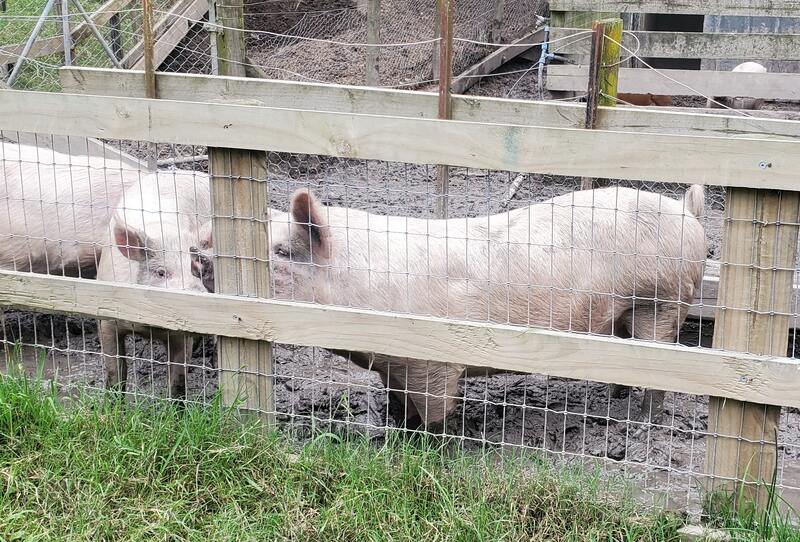
My goal in writing is not to give you the definitive answers. I want to just share my experiences and some ideas so you get a feeling of what you could potentially try and plan out.
This type of butchery has been done for thousands of years – I am not doing anything new – all I want to achieve is spreading some ideas and hoping that someone would want to take them on.
My friends and I get pleasure out of butchery, no idea why, maybe we are hardwired for it. Don’t analyze, just ‘enjoy’ it!
It was 3 to 4 days of work with 2-3 guys when processing this decent-sized pig – butchering/killing comes with honoring the animal, by spending time and effort and producing something worthy.
Guide to Whole Pig Butchery – Smoking & Curing
I will do an overview of:
- Whole Pig Butchery
- Options for Curing and Smoking the Cuts of Meat
I will focus on smoking and curing various cuts of meat with ideas for different muscle groups, and which, of course, can be made into many varied delights!
Like dry-cured salami: In my opinion, this is an advanced aspect of dry curing.
I am very lucky my closest friend has a charcuterie den with all the facilities you could dream of for smoking and curing at home (or commercial for that matter).
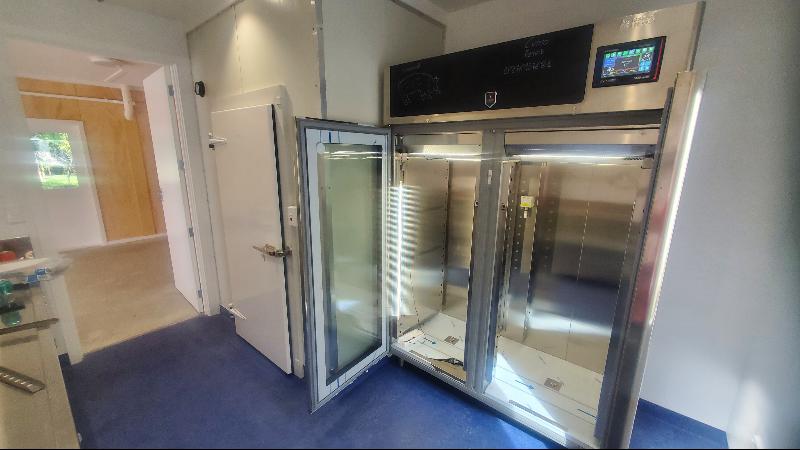
Cooking or Smoking a whole pig is a feast! With some hard work, you can create an array of fantastic preserved products to be savored later in many different ways.
As I have been based in tropical locations recently, I realized certain folks across the world will not have climates conducive to curing and then drying certain cured goods (unless it is done in a DIY curing chamber or the like – I wrote about that here).
Key Steps to Whole Pig Butchery
The assumption is that the pig is dead, and now the work begins:
- Hair Removal
- Gutting
- Remove Head with Saw and Knife
- Half Pig Lengthwise Down Spine
- Hang and Set Meat in a Chiller or Overnight (ideally)
- Remove Feet /Trotters
- Start Dividing into 3 (and Quartering)
- Sort Meat By Whole Muscle or Diced/Mince
- For the recent pig, of maybe 180lb or 90kg, we had 2 or 3 guys doing the butchering (Pete, Dave, and myself) and 2 of us doing the curing, cold smoking, and salami making.
These were some long days, I would say 3-4 days of work (and drinking) in total; including a bit of cold smoking in the evenings.
I just wanted to make sure you are aware of the investment, but the rewards are worth it! (anything worth achieving or doing shouldn’t and isn’t easy!)
1) Hair Removal
We had an old bath and a 40-gallon drum with a fire under it. The water was heated to a scolding temperature and very carefully tipped with long planks of wood, so we could bath the pig.
Shaving and scraping the hair off and keeping the skin on, keeps more fat on the meat, since the fat is under the skin.
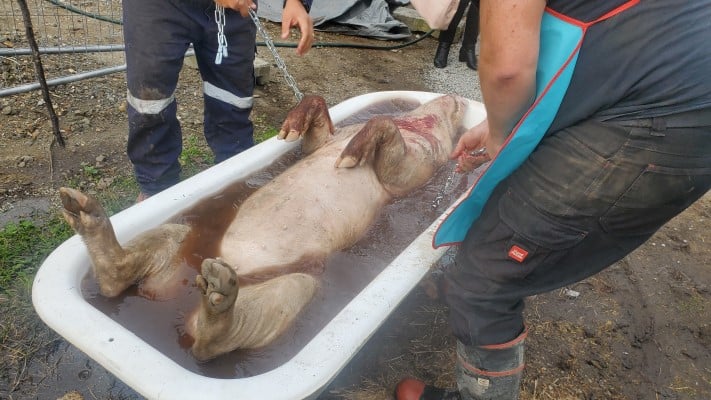
We used the ‘chain’ method to start scrapping the hair off, this worked ok. For this pig, we didn’t quite hit the right scolding temperature, which means more shaving with knives.
Using some other sharp knives, we scrapped more of the hair off.
Then, we had to change over to the blow torch to finish the finer hair removal around the head and other areas.
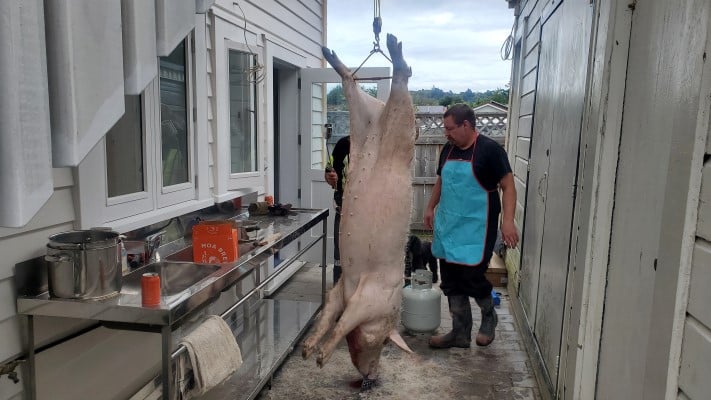
You have to be careful not to overdo the blow torch! Cooking is not wanted at this stage!
Another method is rolling the pig around on a burning straw and then scrapping it with a knife. Any of the methods you use will improve with experience. Like all things in life, you have to ‘get the knack’ of it, because all skills only improve with experience.
2) Gutting
Ideally, it’s hung up to make this job easier, both for finishing off hair and gut removal. Pete, a thinker, has a hanging contraption outside and inside the charcuterie den.
A decent size pig has a lot of guts and you can use many of these parts for many projects:
- Heart (best for same-day consumption)
- Liver (best for same-day consumption)
- Intestines – casings for sausages, salamis
- Tripe – Stomach Lining, Haggis
- Kidney
- Spleen
Here is a link to Pig Farmer offal diagram and some ideas.
Sweetbreads, Pates, Rillettes, Terrines – a plethora of ideas for the traditional use of offal!
Next time, we will talk about that offal spoils the fastest.
3) Remove the Head with Saw and Knife
You need to do a little research on this, but from memory – below the ears, using a knife, saw, then knife again when you get past the bone (spine) and back to the meat.
The head has many tasty bits of meat, more on this later!
4) Half Pig Lengthwise Down the Spine
To work with the main cuts, since a pig has 4 limbs and 2 of most things inside, here is where the good quality meat bone-saw gets good use.
A decent-sized pig around 200 pounds or 100 kg plus will need some serious logistical work. Cutting the pig in half is the first stage of making it a little bit more manageable.
Don’t use a regular hacksaw, unless you want chips of bone.
Unlike a regular hacksaw blade that will splinter bone and cause ragged cuts, meat-saws have teeth that are wider, deeper, and cut through meat and bone smoothly.
https://www.webstaurantstore.com/
5) Hang and Set Meat in a Chiller or Overnight (ideally)
One could hang half the pig the next day, up to you. We liked the idea of halving. If chilled the temperature will drop faster.
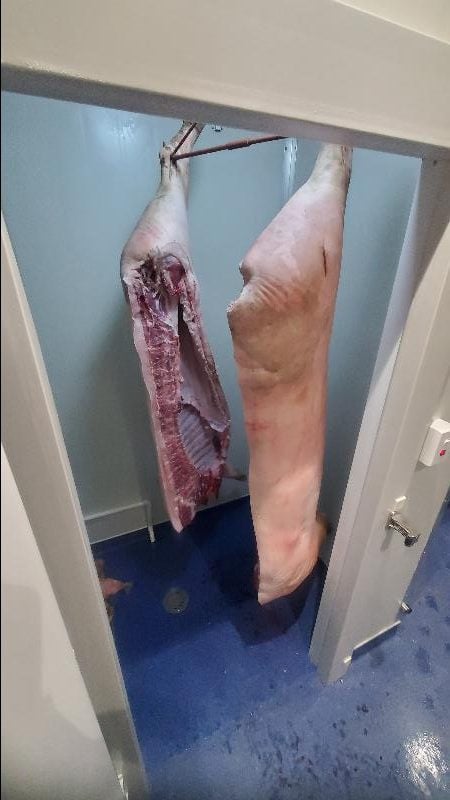
If you can, you shouldn’t be butchering a whole pig unless the temperature is cold, or you are in a large chilly area, without flies, etc.
Letting the meat ‘set’ will make butchery of main muscle groups and subprime cuts a lot easier. It’s firmer and the fat is more solid to cut and work with.
The other important factor is minimizing bacterial growth, it’s incredible how unsalted fresh meat has an exponential growth of unwanted bacteria at temperatures above freezing point!
6) Remove Feet /Trotters
Before or after the steps above use a knife. Some like it for a cleaner edge(up to you). Many Spanish Jamon whole salt-cured hind legs have the trotter/hoof still on it!
Since this is a non-vital step, I go to the more important steps done above, before getting to the hoofs/toes/feet of the pig. (‘Pigs trotters’ is a recipe/dish, too!)
7) Start Dividing into 3 (and Quartering)
There are options here, you can look at doing more steak/chops type of whole pig butchery, which is showcased in this video:
Or because the quartering involves separating the loin from the pork belly – you first make cuts/saw across the hind leg, middle pork belly/loin, and the front shoulder/upper loin for coppa (more on this later).
Front Leg
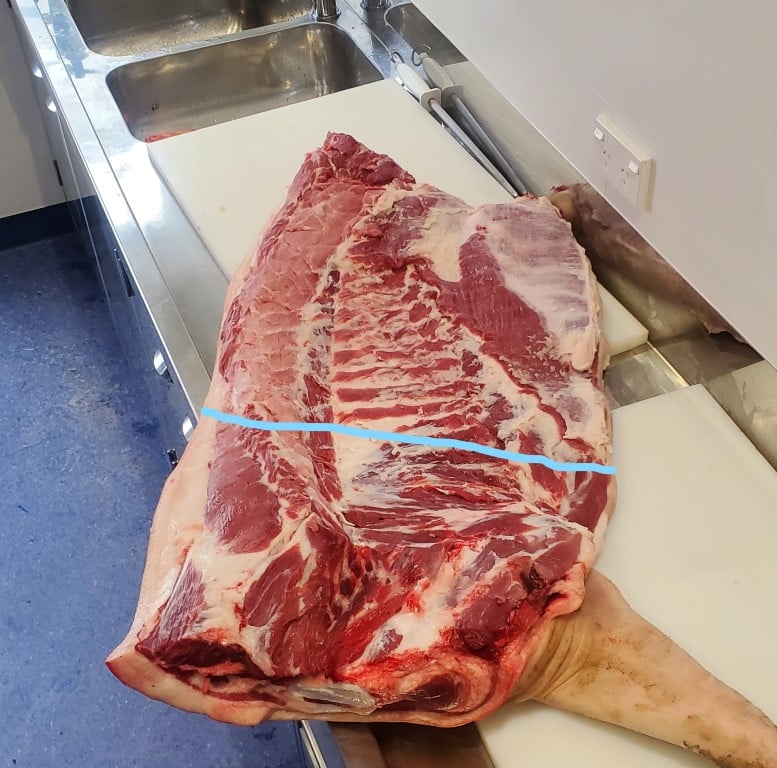
For the traditional cut, there is more than the front leg, since you have the front of the loin, too (coppa). From memory, we took the ribs off before making this cut – separating the main belly from the front leg.
You can use the front leg for sausages, salami, and stew meat.
Another option would be to debone and roll it up, there is a famous classic whole-muscle Italian cut called Spalla (link to info about traditional Spalla). These are like prosciutto cured/dried products that have the bone removed from them.
And is stuffed into a casing.
Loin, Back Fat & Pork Belly
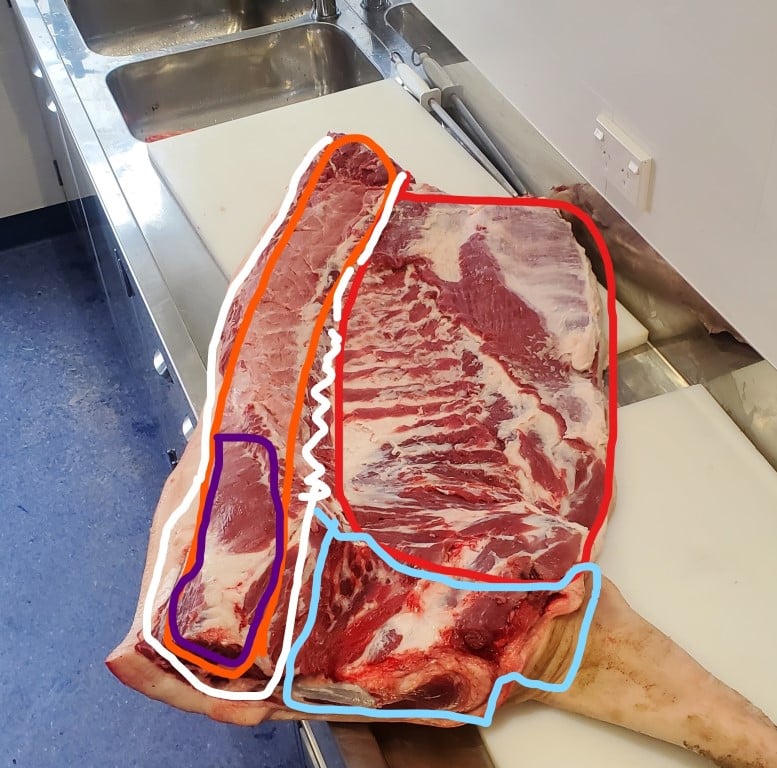
Pork Belly is a rather special part of the whole butchery, the first thing that comes to most people’s minds is bacon. Bacon comes in many different styles and types you will find out!
Here is an article I wrote about 4 different approaches toward the process of making bacon.
I’m currently working on a bacon-making course online, which will cover these ways and techniques for bacon, even making bacon that is ‘smoky’ flavored without using a smoker!
The front shoulder cut from memory is 5 to 6 ribs down from the front (Traditional Italian Style)
Hind Leg Cut (Ham if you like)
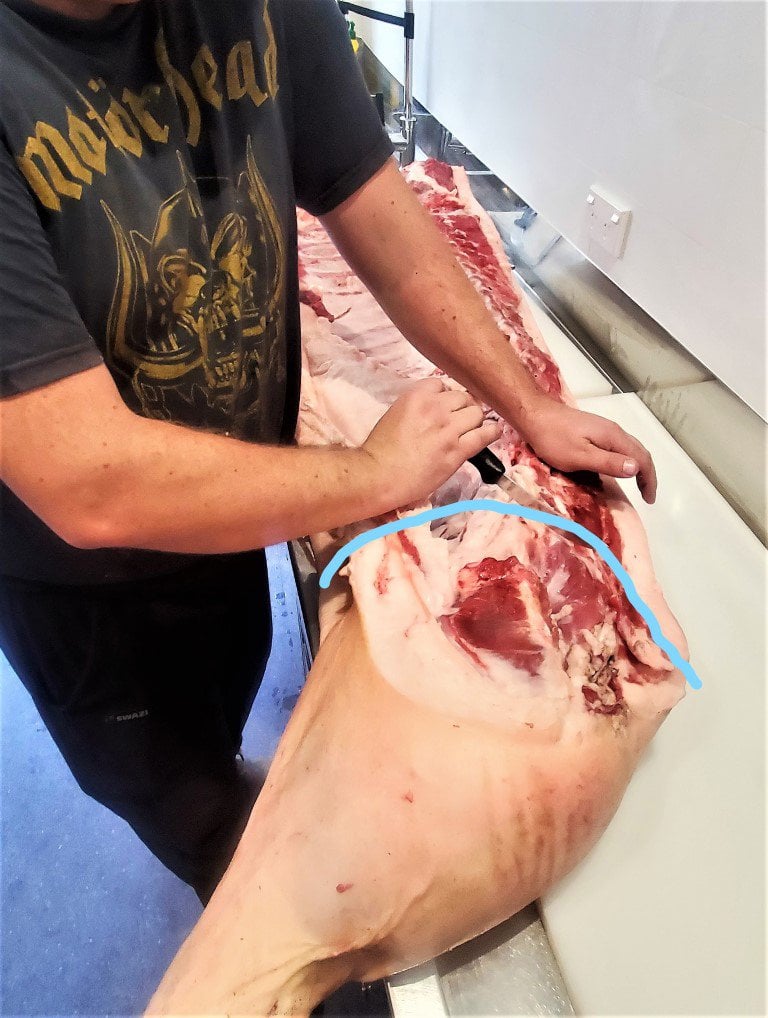
The back leg cut is shown here, this is the cut for hind leg prosciutto, not a traditional hind leg USA butchery cut (let’s call that a ham cut).
A meat hack saw is necessary to make these cuts through the bone parts, whilst a very decent sharp knife should be used for the meat parts of these cuts (these hind legs weighed 22 pounds/11kg).
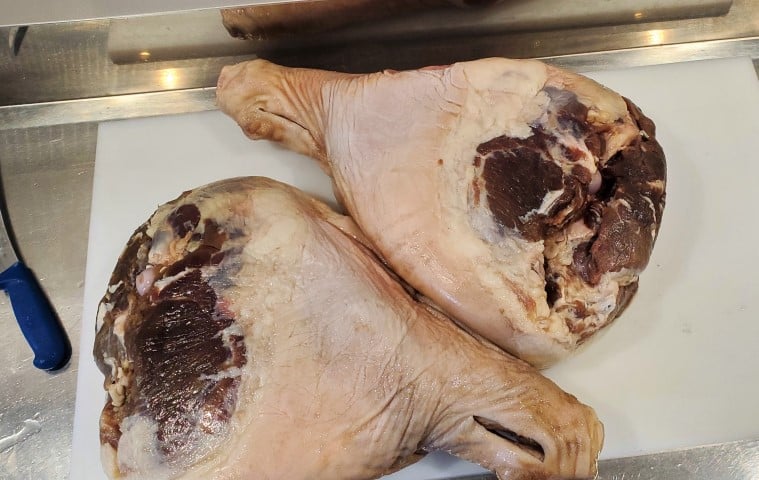
Tenderloin
Tenderloin is an inside steak cut running along the backbone, outside of the gut cavity. Not much flavor some would say, a soft fast frying steak cut, good for a hard-working butcher’s first day, too!
Sort Meat By Whole Muscle or Diced/Minced
There will be many trims and chunks of meat from how you ‘square’ up your cuts, like cuts from Pork Belly for Pancetta. You will want to maybe have it in a rectangular shape. This is helps for hanging, smoking and slicing.
Steaks and chops are always an option.
Loin Steak, Pork Leg Chops, or even simply strips of pork belly.
Different Cuts and Options for Curing and Smoking
The Key Muscle Cuts Each Major Cut and Options
- Head – Jowl, Cheek, Tongue, Brain, Bones
- Loin – Either Whole or Split
- Pork Belly
- Front Legs
- Back Legs
- Back Fat (from under the loin mainly)
How To Smoke and Cure the Whole Muscle Cuts
It would take weeks to write about all the ways and methods I’ve used for different components, instead – I shall give you preferred options for various sections of the pig.
As mentioned, I am here to give you hopefully some ideas, and possibly inspiration for this epic project!
Head
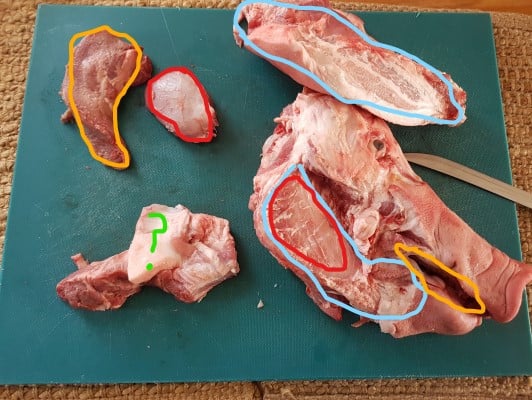
- Jowl
- Cheeks
- Tongue
- Brain
- Bones
- Ears
Sometimes the butcher has pig heads on specials, I’ve found there are quite a few options with a pig’s head.
The main cut for curing I use is the jowl, which is like the meaty part of the jaw behind the cheek. This is a traditional muscle used for making Italian-style Guanciale, which is like an alternative to pancetta.
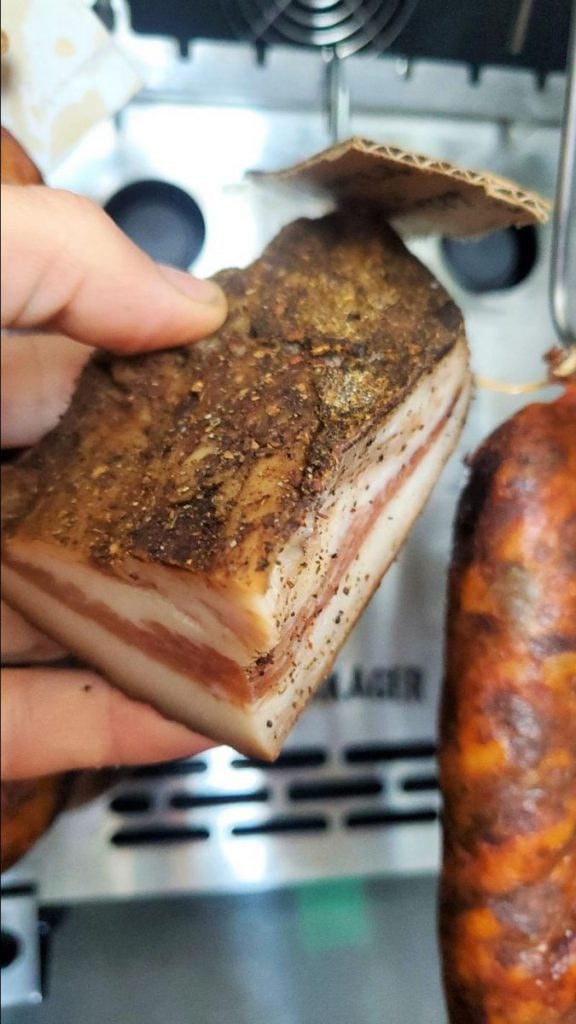
I dry-cure this cut which, depending on the pig, can be 1-3kg/ 2-6 pounds of meat and fat. Often, the fat is quite developed and this is ideal for dry-cured salumi (Salumi is the traditional name in Italian for the major muscle groups of the pig that are dry-cured – for preservation and exciting flavor!)
Often, my guanciale is just a salt and pepper cure before drying and at least 30% weight loss has been achieved. Do note, that the fat does not contain as much water, so the universal guide for fat dry curing of 30% weight loss loosely applies.
I like to wait until the weight loss has ‘leveled out’ and doesn’t seem to lose more weight.
Cheeks and Tongues, I slow cook in herby or spicy broths, like Mexican or Vietnamese Spices/Herbs.
Last time I used the bones and the brain to make pork stock, but I prefer removing the brain. It adds a ‘creaminess’ which is not my desired flavor.
Loin
Often in traditional butchery, the loin becomes some kind of fast-fried steak option. You can, of course, take slices off a whole loin and cook it on the grill, it’s a tender kind of cut, generally.
In traditional Italian Salumi or Spanish style, the loin is dry-cured. However, the top third or quarter of the loin is spiced in Italian style (coppa/capicola).
There are thousands of subtle variations from region to region across Italy, Spain, and other Countries that have done this for many centuries.
To simplify, the upper loin is Italian Coppa (or capicola), and it is said it has the perfect ratio of meat to fat running through it.
Which is 30%!
Now, funnily enough, 30% is a general guide for a meat-to-fat ratio for sausages and salamis, too!
The recipes I have read, heard about, or used for the rest of the loin are based on Lonzo (or Lonzino), which is often just salt and pepper!
The Spanish have Lomo Embuchado for the loin. Pimentón (paprika) and garlic play an important role here, like with much of the Spanish cuisine! I have discovered paprika dried and fresher, but it is a much more exciting product when it has ‘aged’ – many variations in paprika! Not just smoked, Picante (hot) and dulce (sweet).
Pork Belly
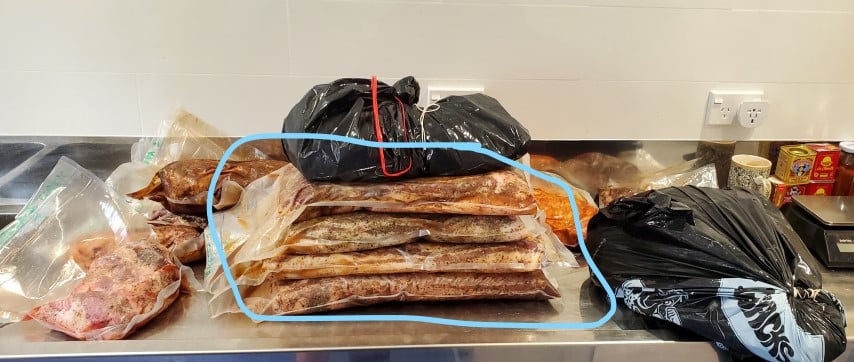
One of my favorite parts of the pig is the pork belly.
Of course, we have bacon and pancetta. Pancetta is a herbed and dry cured style of salumi, the classic for pasta carbonara, BUT according to the Italian Nonna, guanciale is the best for this pasta dish!
Pancetta types of flavoring:
- Black pepper
- Red Pepper Flakes
- Juniper
- Thyme
- Bay leaf
- Garlic Powder
- Fennel Powder
The Spanish style uses garlic and pimentón for this style of Pancetta for this cut, too. However, its journey is the same.
Front Leg
You can leave the front leg bone in or out for a spalla, the front leg version of prosciutto, dry cured salt and pork styled. I prefer to take the time to remove meat/fat from the bones, trim sinew, and use it for sausages and salami.
Spalla is the name for the traditional dry-cured salumi style (Cruda is the dry-cured version in Italian and Cotto is the cooked version like a ham).
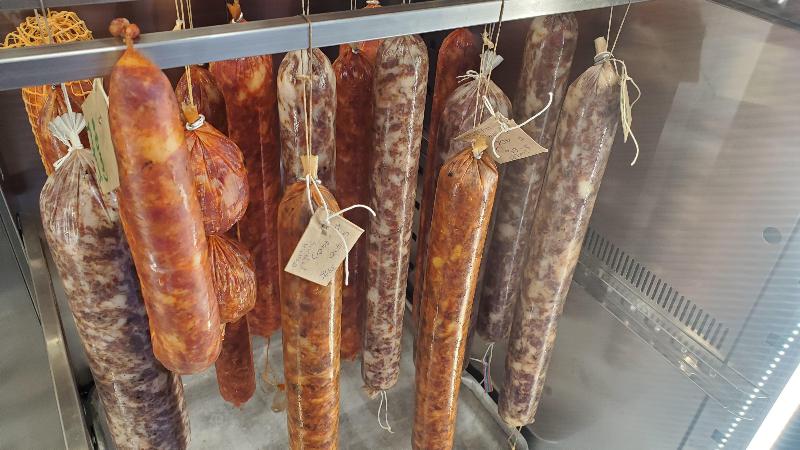
I am talking Chorizo, Soppressata, and Hungarian Cold Smoked Salami!
Back Leg
Prosciutto = Salt + Quality Pork + 12 months + Care + Patience
Culatello, a deboned hind leg, is also an option.
The hind/back leg has less intra-muscular fat, unlike the front leg generally. The fat on the hind leg is on the outside, whilst the front leg has it more dispersed through the meat.
Sausage and minced meat can also be options for the hind legs.
Speck, a German style of dry cold smoked chunk of rump is another option.
Back Fat
Hardback fat is worth a lot since it is very hard to acquire where I live. Most pigs are slaughtered young, so good quality back fat is never developed.
You can cure fat alone with spices and many different types of Lardo.
It’s crucial for sausages and salami. We noticed that the pig was well fed, the shoulder actually carried a lot of intermuscular fat, so we probably didn’t need to add the extra amount to get to a 28-30% target fat percentage.
Often if the pig is well-fed, the shoulder itself should have the right ratio, much like the top of the loin or coppa ratio.
Bones
Low and Slow Ribs and pork stock! These get frozen into usable amounts.
Rib cages you can also just slow roast or hot smoke.
A trick with this is to reduce and concentrate the stock, then freeze it into small tubes or ice cube trays!
Ears
Lately the fashionable and fine dining restaurants have deep-fried or salted and dried pig ears on the menu – pig ears have popped up.
Never used them personally, just thought to mention this – yes you can cook them!
Blood
I know that blood has so many vitamins, minerals, and flavor! The Spanish, German, and other countries are hugely fond of using blood in many cured or cooked products when butchering whole pigs.
Skin
A lot of dry-cured whole muscle cuts have skin on traditionally, this can help or hinder. It will slow drying since the weight loss will be slowed down with the skin on.
I prefer to leave the skin on pork belly pancetta or cold-smoked dry-cured bacon. The finished product will have a wonderful by-product. It’s harder to remove the incredibly tough skin after dry curing, but you have an amazing flavor to throw into stock, stew, or stock pot dishes.
I scissor-cut chunks of this skin and freeze them for down the track.
Also, I like to dehydrate or use the oven on super low (with the door slightly open). Once the skin is as hard as plastic in this temperature you can just cut it with scissors and store it on the shelf in an air-tight jar.
I throw a handful in the air fryer for some epic scratchings!
How to Cure and Smoke the Diced & Minced Bits
Well, this is an in-depth topic I can’t get into detail here.
Here is a summary of our approach whilst butchering a whole pig.
Front shoulders/legs as mentioned, are often deboned and chopped into cubes. This creates the options for sausages and salami!
We have 2 bowels whilst deboning muscles.
For example, one is for the ‘eels’ in the river, which is filled with sinew, any glands (lots around the jowl/head area), and anything that looks unappealing (blood clotting, etc).
The other bowl is from the shoulder/front leg – the ‘sub-prime’ muscle group which is cubed and stored ready for the big job of mincing, mixing, stuffing, fermenting, cold smoking, and eating (eventually)!
Cubed and bagged, for Currys.
Minced and bagged, for dishes that need mince!
Other options For Cured and Smoked Meat from Pork
Jerky or Biltong
You would use salt and vinegar, maybe some other key spices like chili and toasted coriander. Pork isn’t often used for this around here. But you can, of course, make jerky (drier often sweeter) or biltong (my favorite!) out of other meat wild or farmed.
(Vinegar has a denaturing aspect, like cooking it)
Hot Smoked Sausage
Essentially a cooked and smoked salami is, for some recipes, the key to cook them at a low enough temperature so the fat doesn’t render or melt.
Some emulsified meat sausages are cooked and sometimes smoked like Frankfurters or Mortadella.
Pork Pastrami
Brined and pickled, then often smoked and simmered to completion is traditionally not done with pork, but can be done! A deboned front shoulder is ideal for this. A pickled ham!
Smoked Cooked Ham
Like for a Xmas ham, wet brined, and smoked ham, you can use front or back legs for this delight!
Here is a visualisation of whole muscle Italian meat curing, from left to right – guanciale (jowl), coppa (upper loin), pancetta, lardo, lonzino, prosciutto and some speck (from top of hind leg).
Below is my artistic visualization (all cuts are equilibrium cured more info I wrote on this – click here).

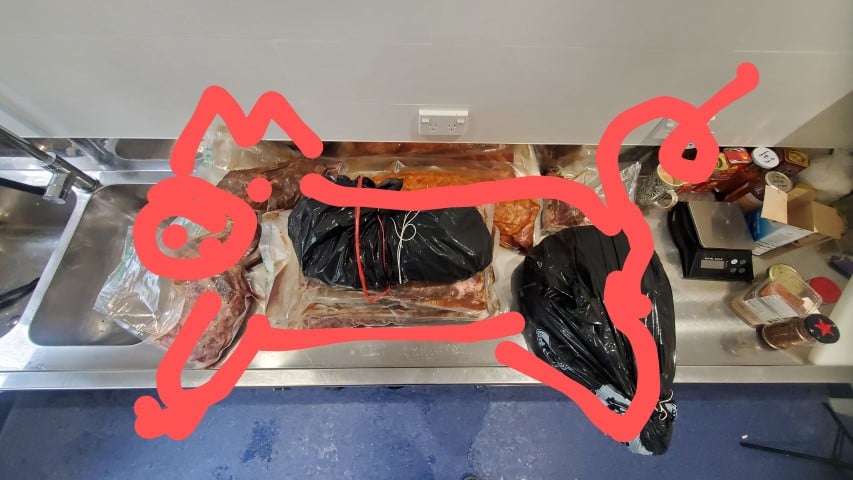

Tom Mueller
For decades, immersed in studying, working, learning, and teaching the craft of meat curing, sharing the passion and showcasing the world of charcuterie and smoked meat. Read More
